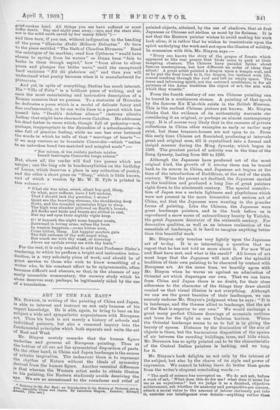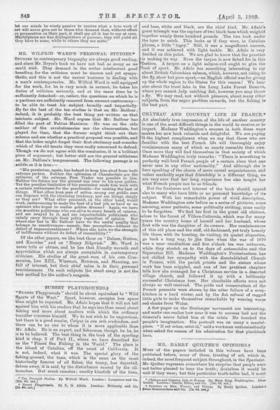ART IN THE FAR EAST.* BINYON, in writing of the
painting of China and Japan, is able to interest and instruct us not only because of his expert knowledge. He is able, again, to bring to bear on his subject a wide and sympathetic acquaintance with European art. Thus his book is not merely a history of schools and individual painters, but also a reasoned inquiry into the fundamental principles which both separate and unite the art of East and West.
Mr. Binyon acutely remarks that the human figure underlies and governs all European painting. Thus at the bottom of all our art lies symmetrical disposition of parts. On the other hand, in China and Japan landscape is the source of artistic inspiration. The endeavour there is to represent the rhythm of Nature without the ideals of symmetry derived from the human figure. Another essential difference ia that whereas the Western artist seeks to obtain illusion in Lis painting, the Eastern studiously avoids deceiving the eye- We are so accustomed to the roundness and relief of
•• Painting in the Par Post, as Introduction to the History of Piotoriat Art In . eapeoially Chins and Japan. By Laurendo Binyoa, London: Edward Araold. Db. not.1
painted objects, attained, by the use of shadows, that at first Japanese or Chinese art strikes us most by its flatness. It is not that the Eastern painter wishes to avoid making his work look alive; it is rather that he wishes to concentrate upon the spirit underlying the work and not upon the illusion of solidity. In connexion with this, Mr. Binyon says :—
" Every one knows the story of the grapes of Zeuxis which appeared so like real grapes that birds came to pock at their tempting clusters. The Chinese have parallel fables about famous masterpieces, but how different an order of ideas they. attest ! A great artist painted a dragon upon a temple wall, and as ho put the final touch to it, the dragon, too instinct with life, soared crashing through the roof and left an empty space.. The inner and informing spirit, not the outward semblance, is for all painters of the Asian tradition the object of art, the aim with which they wrestle."
From the fourth century of our era Chinese painting can be traced in a continuous stream. A painting of that epoch by the famous Ku K'ai-chih exists in the British Museum. This is the earliest Chinese picture yet known. Mr. Binyon thinks that the evidence of its authenticity warrants our considering it an original, or perhaps an almost contemporary copy. It is of course very likely that in the recesses of private collections in China other examples as early or earlier may exist, but these treasure-houses are not open to us. From this early time Chinese art flourished, producing at intervals great and original men, till it crystallised into a formal and insipid manner during the Ming dynasty, which began in 1368. The greatest period of activity was in the time of the Sung dynasty, lasting from 960 to 1280.
Although the Japanese have produced art of the most original kind, the growth of it among them can be traced back to its source in China, and Japanese art begins at the time of the introduction of Buddhism, at the end of the sixth century. When the parent art declined, the Japanese carried on the tradition and produced a long line of great painters right down to the nineteenth century. The special contriba- tion of Japan was a certain lightness and playfulness which were not present in the more hierarchic and serious art of China, not that the Japanese were wanting in the grander forms of painting. Like the Chinese, the Japanese were great landscape painters, and in the book before us is reproduced a snow scene of extraordinary beauty by Yeitoku, the great Japanese decorator of the sixteenth century. For decorative qualities, as well as an intense realisation of the essentials of landscape, it is hard to imagine anything better than this beautiful work.
Mr. Binyon only touches very lightly upon the Japanese art of to-day. It is so interesting a question that we regret that he has not told us more about it. For now West and East have met, and what is the result P All lovers of art must hope that the Japanese will not allow the splendid tradition of their own painting to be obscured by contact with European art. At the same time, we heartily agree with Mr. Binyon when he warns us against an admiration of Oriental art which disparages our own. That we can learn from China and Japan there is no doubt, for their close adherence to the character of the things they draw should remind us that visual illusion is not everything. Although we can see the great beauties of their landscapes, we can scarcely endorse Mr. Binyon's judgment when he says : "It is in landscape, and the themes allied to landscape, that the art of the East is superior to our own." We would exchange a great many perfect Chinese drawings of mountain outlines and trees for the light on one Umbrian horizon. Where the Oriental landscape seems to us to fail is in giving the beauty of spaces. Distance by the diminution of the size of objects is there, but the harmonious disposition of the spaces of air between the receding buildings, trees, and hills which Mr. Berenson has so aptly pointed out to be the characteristic of the Central Italian painters is lacking, and we long for it.
Mr. Binyon'a book delights us not only by the interest of the subject, but also by the charm of its style and power of expression. We cannot in taking leave do better than quote from the writer's eloquent concluding words :—
"The spell of science has corrupted us. We do not ask, before a work of art, What does this do for me? what does it mean for me as an experience?' but we judge it as a finished, objective, achievement, ask whether its anatomy and perspective are correct, attach a moral value to the amount of labour obviously put into it, exercise our intelligence over details—anything rather than
let our minds be wisely passive to receive what a true work of art will never give out to those who demand that, without effort or preparation on their part, it shall say all it has to say at once. Masterpieces are fine distinguishers of persons; they will yield all they have to some, while to others they are mute."











































 Previous page
Previous page